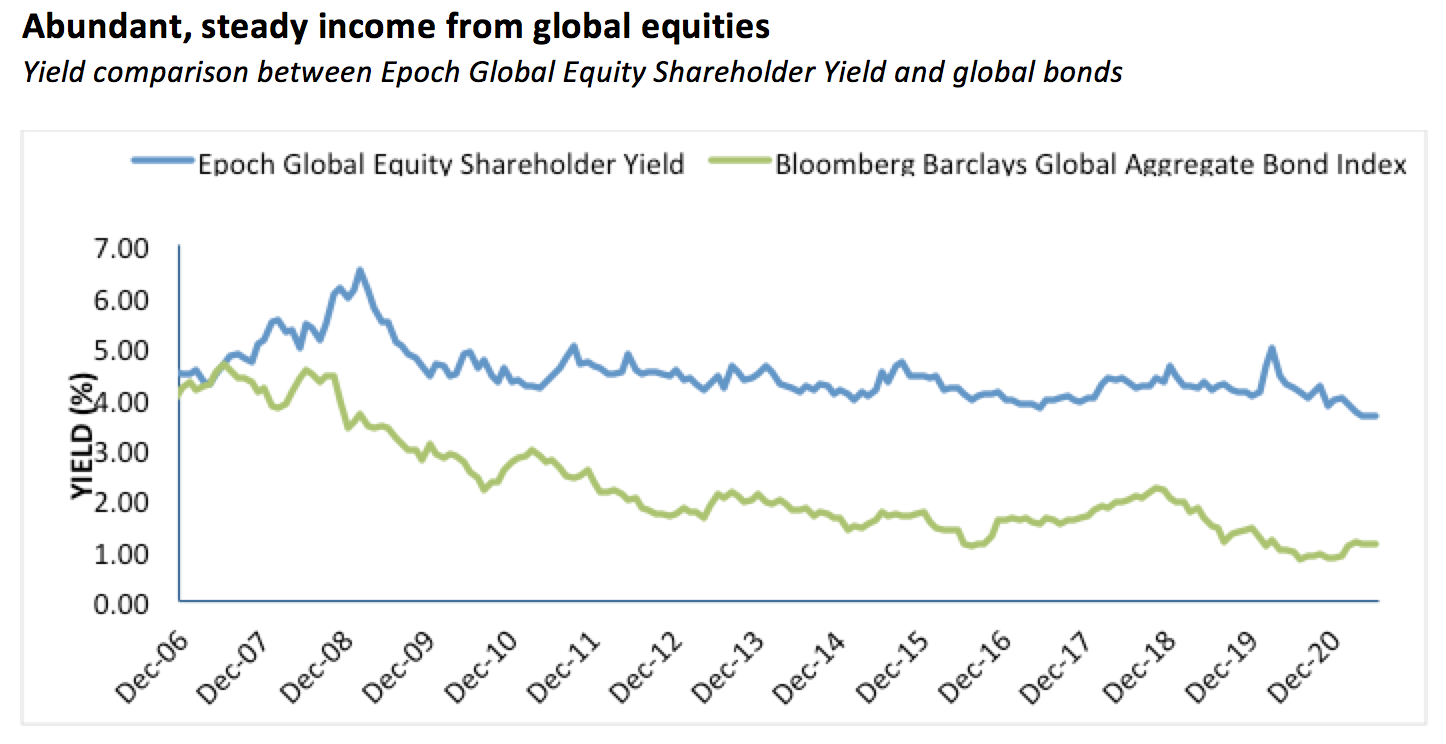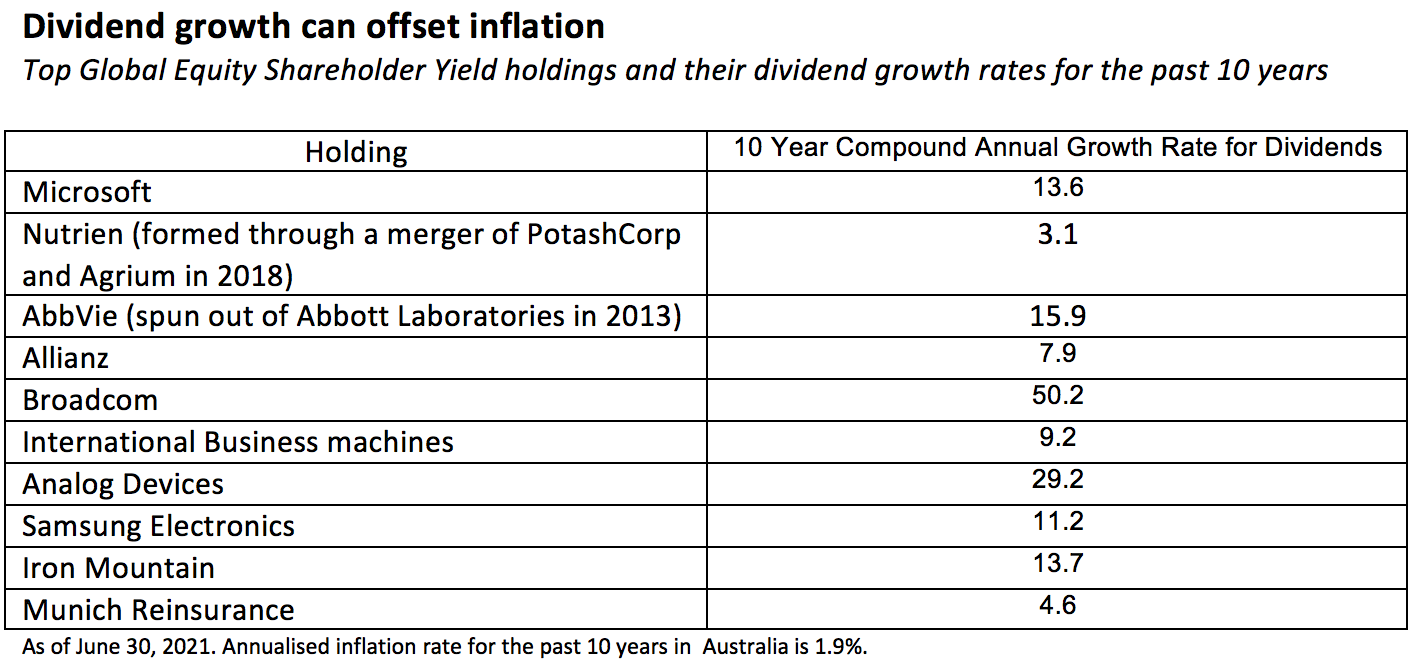The enduring allure and sustainability of dividends
Where will income come from? Today's investors need to know, particularly if they have an eye on retirement and aim to grow their assets while funding anticipated expenses.
Central banks have pushed down bond yields, hurting savers and diminishing what was once the cornerstone of income generation.
The real yields of government bonds (after inflation) are negative in much of the world, including Australia. Until a few years ago, this was thought to be impossible.
Corporate bonds, which entail more risk, are paying little more than their sovereign counterparts, reflecting a seller's market in a yield-starved world.
In this wire I spell out the advantages of investing for dividends, addressing the specific risks of this strategy and how they can be mitigated.
Dividends remain steady despite upheaval
Dividends from equities, however, have remained relatively consistent. Their sustainability has been tested through panics, manias, wars and recessions. The COVID-19 pandemic and the recession it triggered provide us with a recent example of their durability. If we look at stocks that specifically emphasize dividends, the picture gets even better. Yields from this group have held up well relative to bonds (see chart below) and compare favourably to a variety of other income-oriented investments.

Income that can grow and counter inflation
The key attraction of a dividend, of course, is that it is not a fixed coupon. Equities participate in the growth of the economy. If a company can grow its cash flow, it can grow its dividend. This dividend growth can provide a hedge against inflation, and that's before we consider the potential for stock price appreciation.

It's worth noting that finding companies that can grow dividends is the key, rather than finding companies that currently pay a high dividend. After all, a high dividend yield can reflect a one-time windfall or be a sign of distress. (Mathematically, the dividend yield will spike as a company's stock price drops.) Dividend-paying companies must be actively vetted for growing cash flow that can be used to sustain and grow dividends and for company management teams that make paying dividends a priority.

A conservative approach to investing in global equities
It gets better. Dividend paying companies provide investors with more than just dividends. They can also provide a way to invest in global equities with less volatility.
To begin with, companies with a history of growing dividends tend to be mature and well established in their respective markets, with ample resources to ride out economic downturns. Beyond that, dividends provide a measure of stabilization within a portfolio's total returns.
Returns for stock markets can be broken down into three components: dividends, earnings growth (a proxy for free cash flow growth) and valuation multiples (i.e., what investors are willing to pay for the first two).
Dividends are the only component that cannot turn negative; they have been a stabilizing factor for returns every year, going back as far as reliable data exists.
Earnings growth has usually been positive
and is the other primary driver of returns. Valuations (in this case P/E
multiples), on the other hand, expand and contract. Those ups and downs have
largely cancelled each other out over time. For that reason, changes in P/E
multiples have contributed very little to returns.
Click the image to enlarge it
In the chart above note that we use the US stock market because the available data goes back further than it does for global markets.
You may note that the contribution from dividends decreased starting in the early 1990s.
That is due to regulatory changes that made share buybacks an attractive alternative to cash dividends, and companies began to make increasing use of this additional method for returning cash to shareholders.
Because buybacks reduce the outstanding share count, they tend to drive up earnings per share, so some of what used to show up in this analysis as the contribution of dividends has been transferred to the earnings contribution. In our minds, though, dividends and buybacks are equivalent and constitute two of the three possible “shareholder yield” uses of free cash flow (the third being debt reduction).
Epoch's Shareholder Yield approach to investing looks to capture the lion's share of returns from dividends, along with share buybacks and debt reduction.
Focusing on dividend yield also introduces a valuation discipline within the portfolio. If a stock's price moves sharply higher, mathematically that lowers its dividend yield. If the yield becomes too low to contribute to our yield objective for the portfolio, and an acceleration in dividend increases is not apparent, it is no longer a suitable candidate for us to invest in.
We should also mention that our portfolio construction process emphasizes diversification. That being said, our portfolio looks very different than the overall market. Our intent is to make sure that no individual stock contributes a disproportionate share of the portfolio’s dividend yield or cash flow growth.
This approach helps the overall portfolio deliver the income and growth characteristics we seek along with the benefit of lower volatility than the broader market.
Lower volatility results in greater wealth accumulation
Why should an investor care about low volatility? As every investor soon learns, if you earn 50% one year but lose 40% the next, your “average” annual return may be positive (the average of +50 and -40 is +5), but you have 10% less money than you started with.
The dollar you started with grew 50% to $1.50 at the end of the first year, but a drop of 40% from that level means a loss of 60 cents, leaving you with only 90 cents.
Meanwhile, an investor who earned 20% in the first year and lost 10% in the second will have the same average annual return as you, ie, 5%, but she will have $1.08 compared to your 90 cents. (Her dollar first grew to $1.20 then fell 10%, or 12 cents, to $1.08.)
The lesson is that if your portfolio can generate the same average annual return as the market, but does so with less volatility, you will end up with a higher annualised return than the market, ie, you will have more money than if you simply matched the index return each year.
Low volatility is more than just a theoretical talking point; it is a very tangible benefit.
A more reliable approach
We believe investing in growing companies that regularly pay their owners provides a steadier and more dependable outcome than (and a natural complement to) the more prevalent approach of anticipating stock price moves.
Getting the timing right on catalysts, turnaround stories or the next big thing is hard to do with consistency.
We can, however, have a high degree of confidence that a given company will grow its cash flow and that its management intends to distribute a substantial portion of it to shareholders.
For an example to bring that to life, let's compare Toyota and Tesla.
Toyota sold 9.5 million cars in 2020, including nearly two million hybrid electric vehicles. It has a forward P/E of 10.2, a dividend yield of 2.4% and has paid a dividend for the past 35 years. Tesla sold nearly 500,000 electric cars in 2020. It a forward P/E of 136.0 and has yet to pay a dividend. Its market capitalization is nearly triple that of Toyota.
Tesla has been an amazing story. But whether it will grow into its inflated valuation and someday pay a dividend is far from certain. We are reasonably sure, however, that Toyota will continue to generate cash flows and pay a growing dividend regardless of whether the market is up or down.
You can be wrong and still get it right
A current debate at Epoch, and we're pretty sure this is being debated everywhere, is the direction of interest rates and bond yields, especially given the recent spike in inflation.
For what it's worth, we do expect them to climb modestly over the next couple of years.
That has a lot of implications, particularly for stocks with high P/E ratios which can be vulnerable to higher rates. Despite enormous fiscal spending, tolerant central banks and recovering economies, though, concerns about a return to '70s-style inflation are overdone.
Much of the inflationary pressures we are seeing are from supply chain bottlenecks and labor shortages, which we expect will be temporary.
The funny thing is, there was a similar debate at Epoch in late 2005 and early 2006, just as we were launching the Shareholder Yield strategy.
Back then we were convinced that interest rates and bond yields were headed up from their (at the time) historic lows. We envisioned an environment that would hurt the bloated valuations present in much of the equity market at the time, making the Shareholder Yield approach a good place to weather the storm.
We were dead wrong! At least as far as the outlook for interest rates and financial markets is concerned. If we were managing a global macro hedge fund, we would be out of business.
Fortunately, the strategy's focus on companies generating growing free cash flow, and channelling large portions of that cash to shareholders, has done just fine.
Since its inception, its returns have been better than the broader market while its volatility has been meaningfully lower. And, of course, it has provided a substantially higher dividend yield along the way.
So, despite our best estimates, we may not know if the market is overvalued or undervalued, or if the mood will be risk-on or risk-off, or if interest rates will rise or fall. But we do feel confident the Shareholder Yield strategy can provide three things:
· Consistency of income, the most stable driver of long-term returns
· Active management, to determine whether a company’s payouts can grow
· Downside protection/lower volatility, which in the end leads to greater wealth for the investor
As Epoch's executive chairman and co-founder, William Priest, likes to say, "Our Shareholder Yield strategy is the most efficient dividend-collection machine in the world."

My reading list
Curing Corporate Short-Termism: Future Growth vs Current Earnings, Gregory V. Milano
This book was written as a guide for senior managers. It prescribes a set of principles to drive long-term value.
The emphasis given to effective capital allocation aligns with what we look for when considering companies as investments.
Understanding how companies generate cash and how they allocate that cash is central to how we at Epoch think when it comes to assessing companies.
Seek superior total and risk-adjusted returns
Epoch’s Global Equity Shareholder Yield investment strategy is simple, straightforward and based on sound principles: invest in a diversified portfolio of high-quality companies that have a track record of generating growing levels of free cash flow while simultaneously rewarding shareholders with a progressive dividend. The architecture of the strategy makes sense, and it works. Find out more.

5 topics
1 fund mentioned
John is a portfolio manager for Epoch’s Equity Shareholder Yield strategies. Prior to joining Epoch in 2012, John taught undergraduate economics as a lecturer at Fordham University. Before that he spent four years at HSBC Global Asset...
Expertise
John is a portfolio manager for Epoch’s Equity Shareholder Yield strategies. Prior to joining Epoch in 2012, John taught undergraduate economics as a lecturer at Fordham University. Before that he spent four years at HSBC Global Asset...


